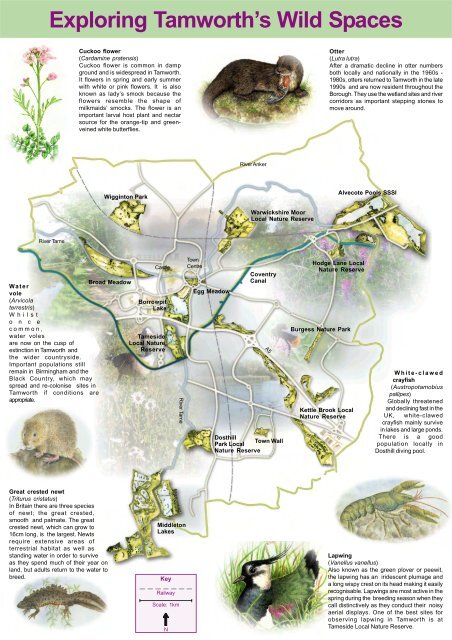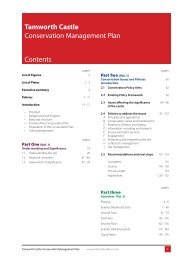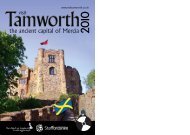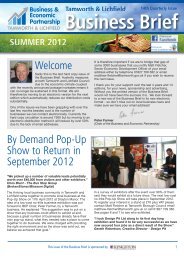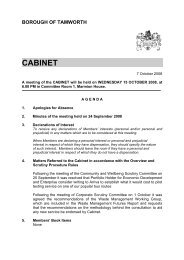Tamworth Wild Spaces leaflet - Tamworth Borough Council
Tamworth Wild Spaces leaflet - Tamworth Borough Council
Tamworth Wild Spaces leaflet - Tamworth Borough Council
Create successful ePaper yourself
Turn your PDF publications into a flip-book with our unique Google optimized e-Paper software.
Exploring <strong>Tamworth</strong>’s <strong>Wild</strong> <strong>Spaces</strong><br />
River Tame<br />
Water<br />
vole<br />
(Arvicola<br />
terrestris)<br />
Whilst<br />
o n c e<br />
common,<br />
water voles<br />
are now on the cusp of<br />
extinction in <strong>Tamworth</strong> and<br />
the wider countryside.<br />
Important populations still<br />
remain in Birmingham and the<br />
Black Country, which may<br />
spread and re-colonise sites in<br />
<strong>Tamworth</strong> if conditions are<br />
appropriate.<br />
Great crested newt<br />
(Triturus cristatus)<br />
In Britain there are three species<br />
of newt; the great crested,<br />
smooth and palmate. The great<br />
crested newt, which can grow to<br />
16cm long, is the largest. Newts<br />
require extensive areas of<br />
terrestrial habitat as well as<br />
standing water in order to survive<br />
as they spend much of their year on<br />
land, but adults return to the water to<br />
breed.<br />
Cuckoo flower<br />
(Cardamine pratensis)<br />
Cuckoo flower is common in damp<br />
ground and is widespread in <strong>Tamworth</strong>.<br />
It flowers in spring and early summer<br />
with white or pink flowers. It is also<br />
known as lady’s smock because the<br />
flowers resemble the shape of<br />
milkmaids’ smocks. The flower is an<br />
important larval host plant and nectar<br />
source for the orange-tip and greenveined<br />
white butterflies.<br />
Wigginton Park<br />
Broad Meadow<br />
Castle<br />
Borrowpit<br />
Lake<br />
Tameside<br />
Local Nature<br />
Reserve<br />
Middleton<br />
Lakes<br />
Key<br />
Railway<br />
Scale: 1km<br />
N<br />
River Tame<br />
Town<br />
Centre<br />
Egg Meadow<br />
River Anker<br />
Warwickshire Moor<br />
Local Nature Reserve<br />
Coventry<br />
Canal<br />
A5<br />
Dosthill<br />
Town Wall<br />
Park Local<br />
Nature Reserve<br />
Alvecote Pools SSSI<br />
Hodge Lane Local<br />
Nature Reserve<br />
Burgess Nature Park<br />
Kettle Brook Local<br />
Nature Reserve<br />
Otter<br />
(Lutra lutra)<br />
After a dramatic decline in otter numbers<br />
both locally and nationally in the 1960s -<br />
1980s, otters returned to <strong>Tamworth</strong> in the late<br />
1990s and are now resident throughout the<br />
<strong>Borough</strong>. They use the wetland sites and river<br />
corridors as important stepping stones to<br />
move around.<br />
White-clawed<br />
crayfish<br />
(Austropotamobius<br />
pallipes)<br />
Globally threatened<br />
and declining fast in the<br />
UK, white-clawed<br />
crayfish mainly survive<br />
in lakes and large ponds.<br />
There is a good<br />
population locally in<br />
Dosthill diving pool.<br />
Lapwing<br />
(Vanellus vanellus)<br />
Also known as the green plover or peewit,<br />
the lapwing has an iridescent plumage and<br />
a long wispy crest on its head making it easily<br />
recognisable. Lapwings are most active in the<br />
spring during the breeding season when they<br />
call distinctively as they conduct their noisy<br />
aerial displays. One of the best sites for<br />
observing lapwing in <strong>Tamworth</strong> is at<br />
Tameside Local Nature Reserve.


